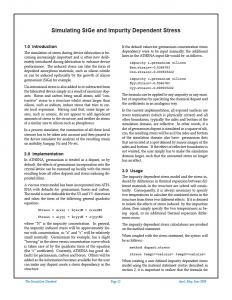Simulating SiGe and Impurity Dependent Stress
1.0 Introduction
The simulation of stress during device fabrication is becoming increasingly important and is often now deliberately introduced during fabrication to enhance device performance. The induced stress can take the form of deposited amorphous materials, such as silicon nitride or can be induced epitaxially by the growth of silicon germanium (SiGe) for example.
Un-intensional stress is also added to or subtracted from the fabricated device simply as a result of necessary dopants. Boron and carbon being small atoms, add “contractive” stress to a structure whilst atoms larger than silicon, such as indium, induce stress that tries to create local expansion. Having said that, some larger atoms, such as arsenic, do not appear to add significant amounts of stress to the structure, and neither do atoms of a similar size to silicon such as phosphorus.
In a process simulator, the summation of all these local stresses has to be taken into account and then passed to the device simulator for analysis of the resulting strain on mobility, bangap, Nc and Nv etc.



